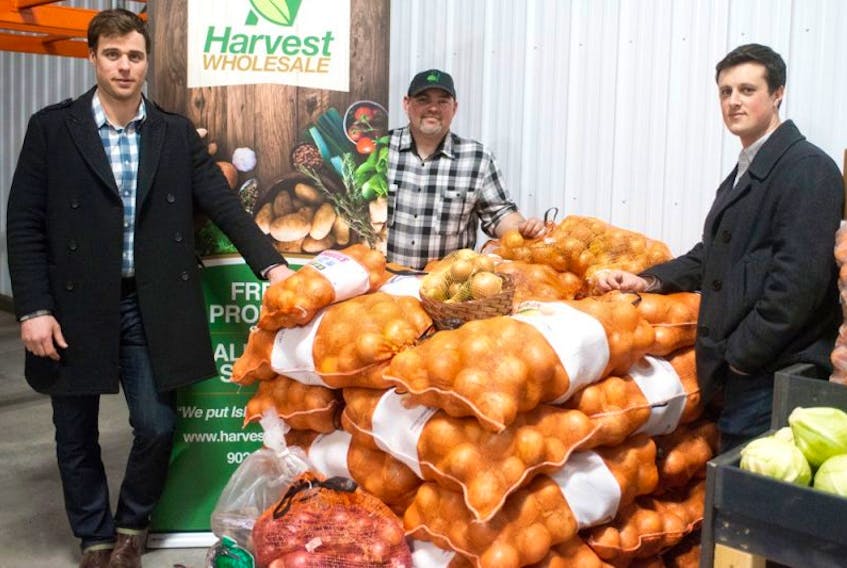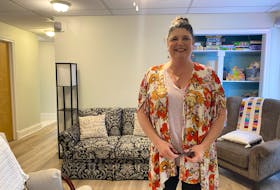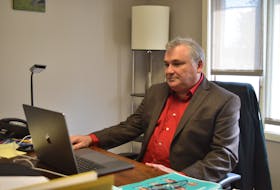By Michael Conor McCarthy
The Guardian
The process by which onions get from a farm to the dinner table at a restaurant is straightforward.
Farmers try to grow high volumes efficiently, which they then sell to middlemen, who then package the onions and ship them off to either restaurants or markets.
This process can take a couple of days or it can be longer when produce is grown in foreign countries on industrialized farms. Most of the time that produce is sold at lower prices than similar products from small, independent farms.
But many Prince Edward Island businesses are finding profitable ways to buy and sell their goods from and back to the Island.
Harvest Wholesale, a P.E.I. owned and operated produce wholesaler, is one of the middlemen making it easier for Island consumers to get their hands on local produce.
The goods that make their way through Harvest’s doors end up in a variety of locations across the Island. They sell to a number of large supermarkets, a few independently-owned restaurants, and to larger groups.
Executive chef at Sims Corner Steakhouse & Oyster Bar, Kyle Panton, said a lot of produce on the Island has always been sourced locally.
“That was kind of the mentality we always had,” said Panton.
“Use local ingredients. We always did at home in my house growing up.”
Panton also owns One Vision Farms, which is where Sims gets a lot of its ingredients.
“I have 100 per cent control. I don’t have to spray anything,” he said about his produce.
Island born Marc Lepine, is the chef-owner of Atelier, a restaurant in Ottawa and one of Canada’s most distinguished chefs. He said that working in Toronto in the mid-90s, he didn’t see restaurants making an effort to buy local ingredients, whereas now it should go without saying.
“There also wasn’t the connection between the growers and chefs that there is now,” he said.
“Chefs have been seeking out more growers.”
Panton thinks Islanders have been too modest about their history with buying and selling local food in the past.
“Now, we’re actually starting to promote ourselves, and say, ‘well, we’ve done this for years,’” he said.
The Food Island Partnership, introduced by the province last year, is aiming to do just that.
One of the stated goals of the initiative is, “To increase the consumption and pride of P.E.I. food products on-Island.”
Josh Patterson, Harvest’s operations manager, said that during the Island’s growing season, about 45 per cent of their goods come from P.E.I. farms.
Patterson said he’s trying to up the percentage of local food that Harvest processes.
“Our goal is to follow the [Food Island’s] mandate as closely as possible, and bring in as much local as possible, but it still has to make sense for our business,” he said.
“We try to work closely with a few local groups and be honest with them.”
Harvest recently expanded into a new building that will help them save on energy costs. On their first full day of operations, the storeroom was stocked with cabbages, mushrooms, eggs, apples and more including a few Island-grown onions.
twitter.com/mcca_conor
By Michael Conor McCarthy
The Guardian
The process by which onions get from a farm to the dinner table at a restaurant is straightforward.
Farmers try to grow high volumes efficiently, which they then sell to middlemen, who then package the onions and ship them off to either restaurants or markets.
This process can take a couple of days or it can be longer when produce is grown in foreign countries on industrialized farms. Most of the time that produce is sold at lower prices than similar products from small, independent farms.
But many Prince Edward Island businesses are finding profitable ways to buy and sell their goods from and back to the Island.
Harvest Wholesale, a P.E.I. owned and operated produce wholesaler, is one of the middlemen making it easier for Island consumers to get their hands on local produce.
The goods that make their way through Harvest’s doors end up in a variety of locations across the Island. They sell to a number of large supermarkets, a few independently-owned restaurants, and to larger groups.
Executive chef at Sims Corner Steakhouse & Oyster Bar, Kyle Panton, said a lot of produce on the Island has always been sourced locally.
“That was kind of the mentality we always had,” said Panton.
“Use local ingredients. We always did at home in my house growing up.”
Panton also owns One Vision Farms, which is where Sims gets a lot of its ingredients.
“I have 100 per cent control. I don’t have to spray anything,” he said about his produce.
Island born Marc Lepine, is the chef-owner of Atelier, a restaurant in Ottawa and one of Canada’s most distinguished chefs. He said that working in Toronto in the mid-90s, he didn’t see restaurants making an effort to buy local ingredients, whereas now it should go without saying.
“There also wasn’t the connection between the growers and chefs that there is now,” he said.
“Chefs have been seeking out more growers.”
Panton thinks Islanders have been too modest about their history with buying and selling local food in the past.
“Now, we’re actually starting to promote ourselves, and say, ‘well, we’ve done this for years,’” he said.
The Food Island Partnership, introduced by the province last year, is aiming to do just that.
One of the stated goals of the initiative is, “To increase the consumption and pride of P.E.I. food products on-Island.”
Josh Patterson, Harvest’s operations manager, said that during the Island’s growing season, about 45 per cent of their goods come from P.E.I. farms.
Patterson said he’s trying to up the percentage of local food that Harvest processes.
“Our goal is to follow the [Food Island’s] mandate as closely as possible, and bring in as much local as possible, but it still has to make sense for our business,” he said.
“We try to work closely with a few local groups and be honest with them.”
Harvest recently expanded into a new building that will help them save on energy costs. On their first full day of operations, the storeroom was stocked with cabbages, mushrooms, eggs, apples and more including a few Island-grown onions.
twitter.com/mcca_conor









